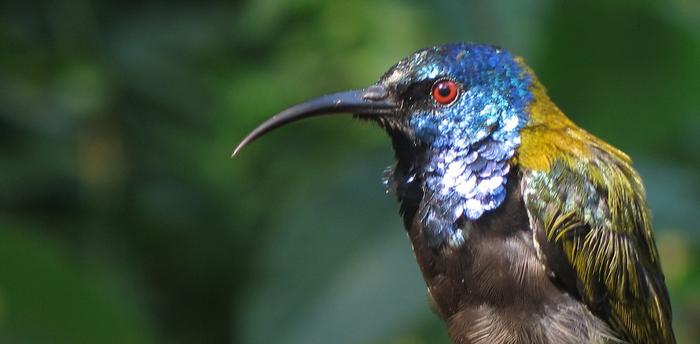Global Bird Family Tree Uncovers Tropical Color Mystery
A groundbreaking study has shed new light on the evolution of colorful bird feathers, challenging long-held assumptions about tropical bird diversity. Researchers analyzed the characteristics of 9,409 bird species to trace the origins and spread of iridescent plumage across the globe. Their findings suggest that the common ancestor of all modern birds likely sported shimmering feathers, setting the stage for the vibrant avian diversity we see today.
The study, published in Nature Ecology and Evolution, used an extensive database of bird species to explore why tropical regions boast more colorful birds than other areas. Contrary to popular belief, the research indicates that many iridescent bird species originated outside the tropics before migrating and diversifying in equatorial regions.
Chad Eliason, a research scientist at the Field Museum in Chicago and lead author of the study, explained, “For decades, scientists have had this hypothesis that there are brighter or more colorful species of birds in the tropics. We wanted to find the mechanism to help us understand these trends– how these bright colors got there and how they spread across the bird family tree over time.”
Unraveling the Mystery of Iridescent Feathers
The researchers employed a combination of photographs, videos, and scientific illustrations to catalog the presence of iridescent feathers in bird species worldwide. By integrating this data with a DNA-based family tree of bird species, they were able to model the most likely evolutionary path of iridescent plumage.
Iridescence, the rainbow-like shimmer that changes depending on the angle of light, is a form of structural coloration. Unlike pigment-based colors, structural colors arise from the way light interacts with microscopic structures in feathers. This phenomenon is responsible for the dazzling displays of many tropical birds, including hummingbirds and birds-of-paradise.
The study’s modeling revealed that iridescent feathers independently evolved 415 times across the bird family tree. Surprisingly, most of these occurrences originated outside tropical regions. Even more intriguing was the discovery that the common ancestor of all modern birds, which lived approximately 80 million years ago, likely possessed iridescent feathers.
“I was very excited to learn that the ancestral state of all birds is iridescence,” Eliason noted. “We’ve found fossil evidence of iridescent birds and other feathered dinosaurs before, by examining fossil feathers and the preserved pigment-producing structures in those feathers. So we know that iridescent feathers existed back in the Cretaceous– those fossils help support the idea from our model that the ancestor of all modern birds was iridescent too.”
This finding has significant implications for paleontology, potentially leading to the discovery of more iridescent features in fossil records. It also raises new questions about the evolutionary drivers behind iridescent plumage.
While the study provides valuable insights into the spread of iridescence across bird species, the initial reason for its evolution remains unclear. Eliason pointed out, “Iridescent feathers can be used by birds to attract mates, but iridescence is related to other aspects of birds’ lives too. For instance, tree swallows change color when the humidity changes, so iridescence could be related to the environment, or it might be related to another physical property of feathers, like water resistance.”
Why it matters: Understanding the evolution of bird coloration not only enriches our knowledge of biodiversity but also provides valuable insights into how species adapt and diversify over time. This research challenges previous assumptions about tropical bird diversity and opens new avenues for exploring the interplay between genetics, environment, and animal coloration.
The study’s comprehensive approach, analyzing over 94% of known bird species, offers a robust foundation for future research. By tracing the origins of iridescent feathers back to the ancestor of all modern birds, scientists now have a new perspective on avian evolution and the development of complex traits.
As researchers continue to unravel the mysteries of bird coloration, this study serves as a stepping stone towards a deeper understanding of how and why nature produces such a stunning array of colors and patterns. Future studies may focus on the specific environmental and genetic factors that drive the evolution of iridescence, potentially leading to new insights in fields ranging from evolutionary biology to biomimetic materials science.
If our reporting has informed or inspired you, please consider making a donation. Every contribution, no matter the size, empowers us to continue delivering accurate, engaging, and trustworthy science and medical news. Independent journalism requires time, effort, and resources—your support ensures we can keep uncovering the stories that matter most to you.
Join us in making knowledge accessible and impactful. Thank you for standing with us!

